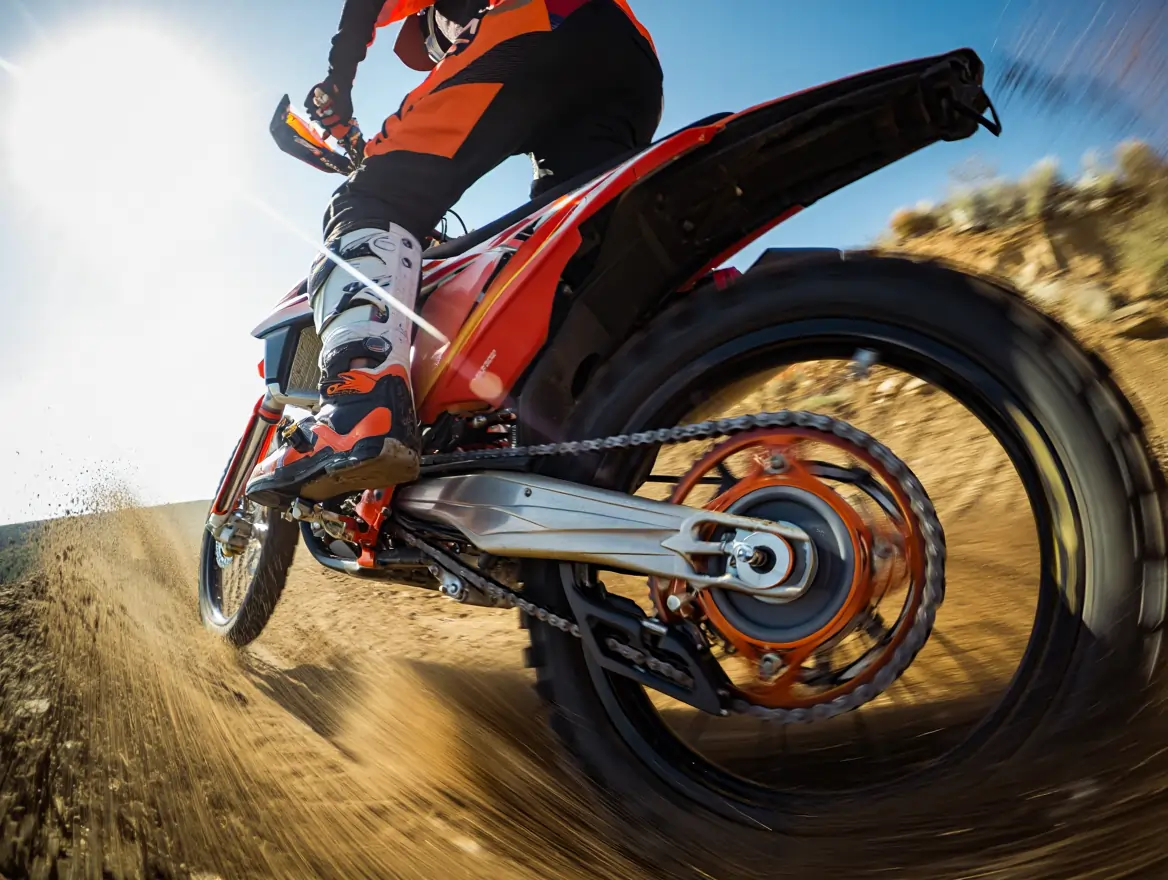I’ve been riding hard enduro for over 15 years, and I currently ride a 2023 KTM 300 EXC. Gearing is one of the simplest, highest‑impact changes you can make to your bike. This guide cuts straight to what works in the real world, especially for 300 2‑strokes and 350 4‑strokes, so you can choose, fit, and test the right combo for your terrain.
What is Enduro → Hard Enduro Basics →
Quick Picks
- 300 2‑Stroke (tight/technical): 14×52 or 13×50
- 300 2‑Stroke (mixed): 14×50 (stock on many bikes)
- 350 4‑Stroke (technical): 14×50
- 350 4‑Stroke (mixed/open): 14×48 (common stock)
- Rule of thumb: -1 front ≈ +3 to +4 rear teeth. Start at stock, then adjust one step.
Enduro Tires: get grip right too → · Deep dive: Hard Enduro Tire Systems
How Gearing Works (Fast)
Gearing ratio = rear teeth ÷ front teeth. Higher ratio = lower gearing (more torque, lower top speed). Lower ratio = taller gearing (more top speed, less snap at low RPM).
- Lower gearing (bigger rear or smaller front): Better control on steep, rocky, muddy and slow terrain. Perfect for hard enduro.
- Higher gearing (smaller rear or bigger front): Better for fast, open trails and sand; requires more clutch at low speed.
Step‑by‑Step: Choose Your Ratio
1. Define your terrain
- Mostly technical/slow? Aim lower (e.g., 3.70–4.00).
- Mostly open/fast? Aim higher (e.g., 3.40–3.60).
2. Start from stock
- KTM 300 EXC: typically 14×50 (3.57)
- 350 4T enduro (varies by brand): commonly 14×48 (3.43)
3. Make one change at a time
- Try +2 rear teeth or -1 front tooth; test the same loop.
4. Check chain length and clearance
- Larger rears/smaller fronts may need more links and can increase chain slider wear.
5. Test, then fine‑tune
- Evaluate clutch use, stall risk, climb control, and cruising RPM.
Pro tip: Carry a spare 13T countershaft sprocket. It’s cheap, quick to swap, and equivalent to ~+3 to +4 rear teeth.
Proven Setups by Bike Type
300cc 2‑Strokes
- 14×50 (3.57): Excellent all‑rounder for mixed enduro.
- 14×52 (3.71): Hard enduro and slow, technical terrain; improved lugging and control.
- 13×50 (3.85): Maximum low‑end for very steep/rocky; watch chain slider wear.
My bike: On the 2023 KTM 300 EXC, I run 14×52 for extreme terrain and 14×50 when I expect faster liaison sections.
350cc 4‑Strokes
- 14×48 (3.43): Balanced stock‑style setup for mixed terrain.
- 14×50 (3.57): Adds technical control and tractability without killing cruise speed.
- 13×48 (3.69): Strong low‑end feel; mind chain slider wear vs. a rear‑only change.
Related: If you’re choosing a 300 2‑stroke for hard enduro, read the Buyer’s Guide for platform differences and recommendations.
Ratio Benchmarks and Use‑Cases
| Front | Rear | Ratio | Best Use |
|---|---|---|---|
| 13 | 46 | 3.54 | Open terrain, faster flow |
| 13 | 49 | 3.77 | Mixed terrain, more punch |
| 13 | 50 | 3.85 | Technical climbs, hard enduro torque |
| 13 | 52 | 4.00 | Very steep/slow, maximum control |
| 14 | 48 | 3.43 | Versatile, trail + liaison |
| 14 | 50 | 3.57 | Technical trails, strong lugging |
| 14 | 52 | 3.71 | Hard enduro focus, low‑speed precision |
Remember: -1T on the front ≈ +3–4T on the rear.
Chain Length, Fitment and Wear
- Chain length: Bigger rear/smaller front often needs additional links (e.g., 112→114→116). Check your adjuster range before riding.
- Slider wear: 13T fronts can accelerate chain slider wear. If possible, prefer adding rear teeth for longevity.
- Alignment and tension: After changing sprockets, set correct slack and verify alignment to protect the swingarm, guide, and bearings.
- Replace as a set: Chain + both sprockets wear together. Replacing all three extends life and keeps power delivery smooth.
2‑Stroke vs 4‑Stroke Gearing Feel
- 2‑Strokes: Snappy, benefit from slightly lower gearing to keep the motor in the meat without excess clutch.
- 4‑Strokes: Broader torque, tolerate a wider range of ratios; engine braking helps on descents.
Skill support: Sharpen your control with Mastering Throttle Control and Expert Braking Techniques.
Testing Protocol (10‑Minute Loop)
- Warm up, then ride a short loop with climbs, slow turns, and a brief fast section.
- Note clutch use, stall risk, and lugging at low RPM. Aim to reduce clutch work.
- On the fast section, check comfortable cruise RPM and noise levels.
- If you’re slipping the clutch a lot in the slow bits, go lower. If you’re revving out on the fast bits, go taller.
FAQs
Do I change the front or rear first? If you need a big change fast, swap the front (cheap, quick). For fine‑tuning and longevity, add teeth to the rear.
Will 13T chew my slider? It can increase wear. Many riders accept it for events, then revert. Inspect regularly.
What about sand/desert gearing? Go taller (e.g., 14×48) to reduce revs and heat. Pair with the right tire/mousse setup; see Enduro Tires.
Best spare to carry for races? A 13T countershaft sprocket in your kit and a few extra chain links in the van.
Related Reading on Enduro Wow
- Hard Enduro – What to Expect
- What Is Enduro?
- Enduro Tires – Choose the Right Setup
- Mastering Throttle Control
- Expert Braking Techniques
If you have a specific bike and terrain combo you want dialed, tell me your current sprockets and riding conditions, I’ll suggest a starting ratio and chain length that fits your swingarm range.























































